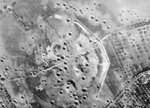Merville Gun Battery
| Type | 25 Fortification | |
| Historical Name of Location | Merville, Basse-Normandie, France | |
| Coordinates | 49.269444000, -0.197778000 |
Contributor: Alan Chanter
ww2dbaseSituated near the mouth of the River Dives the powerful coastal gun battery, constructed near the small village of Merville in northern France, constituted, in the spring of 1944, a very serious menace to the Allied invasion forces, for its very location overlooked the left flank of "Sword" beach where the the British 3rd Infantry Division were intending to land. This was the 1st Battery, Artillerie-Regiment 1716, commanded on D-Day by Sub-Lieutenant Steiner, temporarily in command since Kaptain Welter had been killed, along with his mistress on the eve of 19-20 May 1944 during a bombing raid.
ww2dbaseAllied Intelligence believed that the battery comprised four 150-millimetre guns with an estimated range of over thirteen miles. In reality they were 100-millimetre Czech Le FH 14/19(t) howitzers with a range of less than ten kilometres, but even so they still posed a severe danger to Allied troop movements in the "Sword" Sector. The guns were housed in a complex of concrete bunkers and emplacements, with walls some twelve feet high and five feet deep, with a thickness of six feet six inches. Above the emplacements was a thirteen feet thick earth covering providing additional defence against bombs and shells. All doors giving access to the complex were constructed of steel and were defended by one 20-millimetre gun (capable of deployment against both air or land targets), and numerous machine guns. The battery was surrounded by a cattle fence enclosing a dense minefield some 100 metres wide and within the minefield a barbed wire entanglement some fifteen feet thick and five feet high added further strength to the defences. Also, in a number of places within the complex, it was believed by Allied Intelligence reports, that the wire had been doubled in thickness making it an even more formidable obstacle. On the seaward side of the battery was an anti-tank ditch some fifteen feet wide and ten feet deep. More minefields covered the open approaches to the battery as a final defence, and these too were covered by numerous machine-gun positions.
ww2dbaseIn total, perhaps 200 Germans were available to defend the position. Therefore it was of no surprise that, when Lieutenant Colonel Terence Otley was given the task of eliminating the Merville battery prior to the invasion, his Brigadier acknowledged discouragingly that 9 Para's mission was to be "a real stinker".
ww2dbaseSources:
David Howarth, Dawn of D-Day (Fontana Books,1961)
David Bickley, The assault by 9th Parachute Battalion on the Merville Battery (Wargames Illustrated 183, December 2002)
Paul Carell, D-Day - Invasion They're Coming! (Corgi Books,1963)
Cornelius Ryan. The Longest Day (New English Library, 1969)
Last Major Update: Jan 2014
Merville Gun Battery Interactive Map
Photographs
 |
Please consider supporting us on Patreon. Even $1 per month will go a long way! Thank you. Please help us spread the word: Stay updated with WW2DB: |

Merville, Basse-Normandie, France
Latitude-Longitude:
49.2694, -0.1978
- » 1,177 biographies
- » 337 events
- » 44,933 timeline entries
- » 1,245 ships
- » 350 aircraft models
- » 207 vehicle models
- » 376 weapon models
- » 123 historical documents
- » 261 facilities
- » 470 book reviews
- » 28,474 photos
- » 365 maps
Fleet Admiral Chester W. Nimitz, 16 Mar 1945